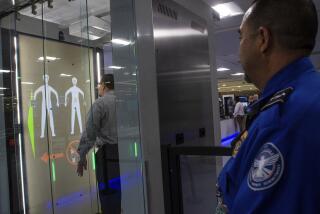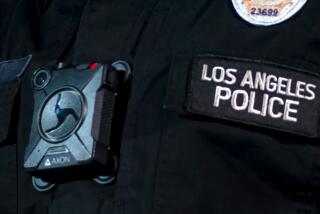Public gets chance to comment on TSA’s full-body scanners
Airline passengers have been walking through full-body scanners for nearly five years, but only now are fliers getting a chance to officially tell the federal government what they think about the screening machines.
In response to a lawsuit, the U.S. Court of Appeals for the District of Columbia circuit ruled that the Transportation Security Administration could continue to use the scanners as a primary method of screening passengers. But the court ordered the TSA to give the public a 90-day comment period, which the agency did not do when it launched the scanning program.
The TSA began the comment period online in March, and so far it has been getting an average of 26 comments a day — nearly all of which blast the TSA and the scanners for a variety of reasons.
The most common objection is that the scanners violate the Constitution’s 4th Amendment, which guards against unreasonable search and seizure.
“Screening without probable cause is a violation of the 4th Amendment to the U.S. Constitution,” wrote Russell Yates of Los Angeles.
But in the 2011 ruling, the U.S. Court of Appeals rejected that argument, saying that “screening passengers at an airport is an ‘administrative search’ because the primary goal is not to determine whether any passenger has committed a crime but rather to protect the public from a terrorist attack.”
Other common objections to the scanners say they expose passengers to unsafe levels of radiation and are not effective at stopping terrorists.
“It is scientifically indefensible to irradiate the vast majority of passengers,” wrote Richard Layton of Terre Haute, Ind. The TSA says several studies show the scans pose no significant hazard to passengers.
Finally, several dozen critics said the government doesn’t have the right to take “naked” or “nude” pictures of them to look for hidden weapons.
That may be a moot point. In response to a new federal law, the TSA is expected to remove all scanners that generate what look like naked images of passengers from airports by summer.
Most of those scanners will be replaced by a type of scanner that shows hidden objects projected onto a generic avatar image on a screen — not on a nude-like image of a passenger.
To add your comments, visit www.regulations.gov and type in the case code TSA-2013-0004.
ALSO:
TSA ends contract with Rapiscan, maker of full-body scanner
2011: Airport scanners pose ‘trivial’ radiation risk, report says
2011: Less invasive body scanner software tested at airports
More to Read
Inside the business of entertainment
The Wide Shot brings you news, analysis and insights on everything from streaming wars to production — and what it all means for the future.
You may occasionally receive promotional content from the Los Angeles Times.











